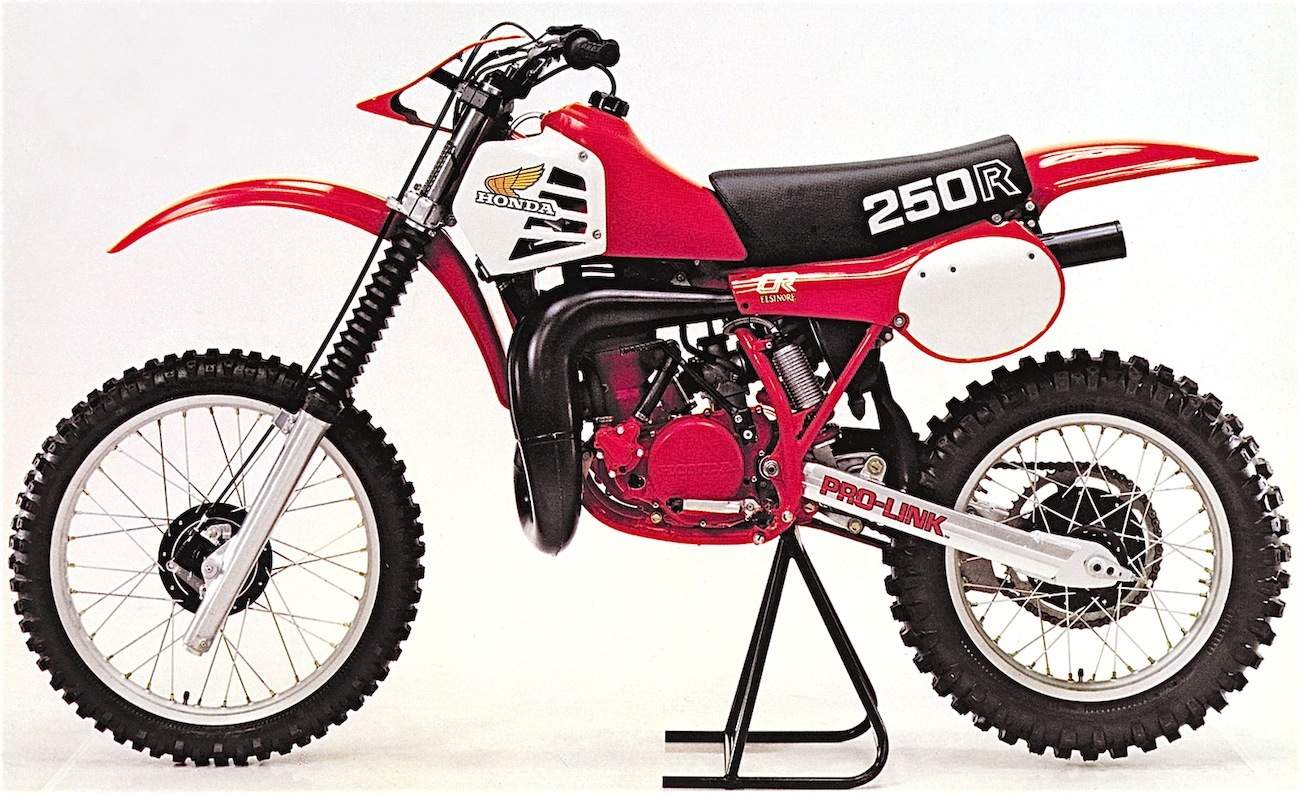CLASSIC MOTOCROSS IRON: 1981 HONDA CR250R
There is little doubt that 1981 was an interesting year for Honda. The manufacturer went all Star Wars on its cosmetics, plus water-cooled the CR125 and CR250, introduced the ill-fated CR450 and unveiled the stupidest front number plate in motocross history. Still, the 1981 CR250 tried to bring exotic works technology to the production line. It was the first-ever, water-cooled, 250cc production bike. Borrowing works technology, the 1981 CR250 shared the works bike’s long-stroke engine design, center port exhaust, semi-double-cradle frame and Pro-Link single-shock suspension. Although Honda wasn’t the first to put a single-shock system on a production bike, the Pro-Link setup proved to be a precursor for all the linkage designs in use today.
 In 1981 Honda broke away from Showa to outfit the CR250 with Kayaba components. Honda wasn’t ready to go to disc brakes in 1981, but it did equip the CR250 with a double-leading-shoe front drum that worked very well. There were problems, though. The frames had a tendency to break, the clutch slipped, the head pipe hung below the frame and the transmission popped out of third gear constantly. Even worse, the 1981 CR250 weighed a ton, and the wing-like front number plate, designed to get more air to the two small radiators, was so ugly that nobody ever raced with it.
In 1981 Honda broke away from Showa to outfit the CR250 with Kayaba components. Honda wasn’t ready to go to disc brakes in 1981, but it did equip the CR250 with a double-leading-shoe front drum that worked very well. There were problems, though. The frames had a tendency to break, the clutch slipped, the head pipe hung below the frame and the transmission popped out of third gear constantly. Even worse, the 1981 CR250 weighed a ton, and the wing-like front number plate, designed to get more air to the two small radiators, was so ugly that nobody ever raced with it.
THE ODDITY EXTRAPOLATION
The 1981 Honda CR250 is collectible only because of its unique place in history. Not a great bike by any stretch of the imagination, it is memorable for its ground-breaking technology and ugly aesthetics. Even oddities can have a following, which is why collector bikes must have the original wing-style front number plate, along with the double-leading-shoe front brake and remote reservoir, four-click adjustable shock.
 The domestic Japanese CR250 had an equally weird front number plates, designed to get max air to the twin radiators.
The domestic Japanese CR250 had an equally weird front number plates, designed to get max air to the twin radiators.
The Japanese domestic version did not have the wing-like front number plate, but then none of the American models had them once the buyers got the bike home. The domestic Japanese model (shown above) had a forward facing, but very small front number plate (with the same wire screen below it as the American model).
Honda’s former MXGP team manager Roger Harvey, a GP racer himself, had some behind-the-scenes info about the 1981 CR250, he told MXA that, “It was rightly written in the Classic Iron article that the US CR250 model was fitted with the ‘stupidest front number plate in motocross history. The Japanese model had a strange, but more conventional front plate and the European bikes had a conventional-style front plate. At an MXGP event some years ago a press guy asked me quiet randomly, “Can you please explain why Honda fitted those front number plates to the U.S. CR250s back in 1981?” I didn’t have a clue and I told him that I didn’t hold out much hope of finding the answer because most of the engineers from that era would almost certainly have retired.
“As luck would have it, we had a Japanese engineer with us that weekend, who only came to an event a few times a year, and I mentioned the story to him in case he might know one of the old guys that worked on the bikes back then. His reply astounded me, he said, ‘I know why they designed it that way because I worked on the development team for that model.'”
“I couldn’t believe that I was about the find out why the ‘stupidest front number plate in motocross history” was designed that way,” said Roger.
The engineer said it was obvious why this strange number plate was fitted to the American models, he said, “Where are the spectators at an American Supercross event? They are watching from up above the riders, so we designed this plate so the spectators could see the rider’s number from the stands!”






Comments are closed.